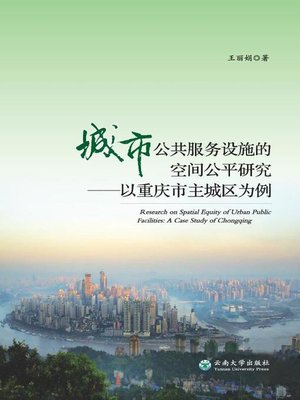城市公共服务设施的空间公平研究 (Study of Spatial Equity of Urban Public Facilities)
ebook ∣ 以重庆市主城区为例 (A Case Study of the Urban Centre of Chongqing)
By 王丽娟

Sign up to save your library
With an OverDrive account, you can save your favorite libraries for at-a-glance information about availability. Find out more about OverDrive accounts.
Find this title in Libby, the library reading app by OverDrive.



Search for a digital library with this title
Title found at these libraries:
| Library Name | Distance |
|---|---|
| Loading... |
城市公共服务设施是城市公共服务的空间载体,其空间分布事关居民生活质量和社会公平,是城市地理学研究的一个重要领域。我国现阶段正处于生存型社会向发展型社会转变的时期,城市居民需求开始从基本生存资料转向发展资料和享受资料,必将对公共服务供给在质和量上提出更高、更多元化的要求。但由于公共资源集中、规模化配置与居住空间分异现象突出,不同社会阶层群体对有限的公共资源不能享有同等的接近机会。如何保证城市公共资源有效供给与合理分布,使不同社会阶层群体能得到相对公平的公共服务,营造机会公平的社会环境是建设公共服务型政府的必然要求。国内研究大多基于区域宏观尺度,围绕公共政策、公共管理等内容进行定性探讨,忽视城市内部整体空间布局和社会空间分布,缺乏从城市地理学的空间视角进行务实探索的研究。因此,有必要借鉴国外相关理论开展我国城市公共服务设施空间公平研究,丰富城市公共服务设施公平性理论,为公共服务设施空间分布的供需矛盾、合理布局寻找实践切入点。
基于以上目的,本研究选择非邻避型的公益性公共服务设施为研究对象,以重庆为案例地域,基于地理信息系统,从总体和典型区域两个层面对城市公共服务设施的空间公平进行实证研究。全书首先对国内外相关研究及相关概念与理论基础进行综述;其次是城市公共服务设施空间公平的价值取向、内涵、形成机制的理论构建;接着分别建立城市公共服务设施机会公平与绩效公平的评价体系,并结合案例,从总体层面定量评价公益性公共服务设施的机会公平性,从典型区域层面通过分析公共设施可达性空间优势度与城市经济空间优势度的耦合关系评价城市公共服务设施的绩效公平;在实证研究的基础上,探讨城市公共服务设施空间不公平的形成机制,从认识、规划、技术、制度等四个层面构建城市公共服务设施空间公平框架;最后形成结论,总结研究创新和不足,提出进一步的研究方向。(Urban public service facilities are spatial dimension of urban public services. Its spatial distribution has to do with the living standards and social equity of residents. It is an important sphere of urban geography.China is transforming from survival-oriented society to development-oriented society. The needs of urban residents have changed from basic survival materials to materials for development and lifestyle, which means means an upgrade of public services in terms of quality, quantity and diversity.Due to the concentration of public resources, scale configuration and residential space differentiation, different social groups cannot have equal access to limited public resources.Ensuring effective supply and reasonable distribution of urban public resources, providing relatively equal public services of different social groups, and creating a social environment of equal chances are the necessary requirements to building a public-service-oriented government.Most studies in China are based on macroscale of regions, focusing on public polices and public management, etc., and ignoring the internal spatial structure and distribution of social spaces and failing to explore in a practical way from the spatial perspective of urban geography.Hence it is necessary to study related theories of foreign countries to inform our research of Chinese urban public facilities, enrich the equity theories of urban public facilities, and find a vantage point for the supply-demand gap and reasonable layout of urban public facilities.
To this end, this study chooses non-NIMBY urban public facilities as subject, Chongqing as the site of the case, and GIS, to conduct empirical study of the spatial equity of urban public facilities in general terms and in terms of typical regions.The book begins with an overview of existing studies, concepts and theoretical basis at home and abroad, which is followed by theoretical framework of the value, connotation and formation mechanism of spatial equity of urban public facilities. The next part is an assessment system of fair chance and fair performance of urban public facilities. With case studies it offers a quantitative assessment in general terms of the chance fairness of non-profit urban public facilities. In terms of typical regions it assesses the performance fairness of urban public facilities through analysis of the coupling relation of accessible spatial advantages and urban economic spatial advantages; based on empirical studies the book discusses the formation mechanism of unfairness of urban public facilities , and builds a framework of spatial equity of urban public facilities from awareness, planning, technology and institution levels; the book ends with a conclusion, review of the innovation and inadequacies, and further directions.)






